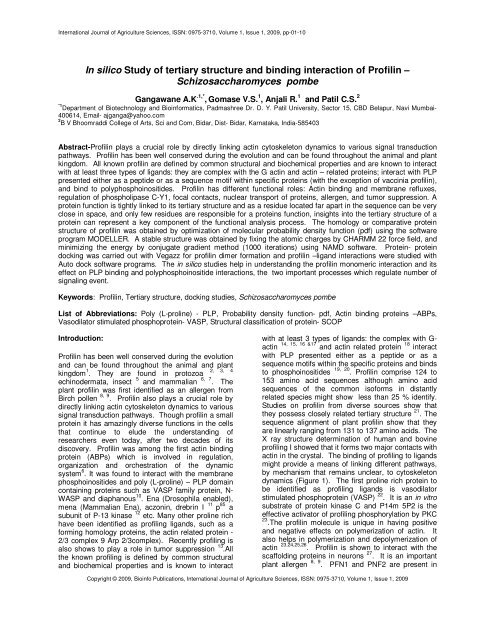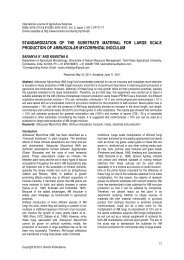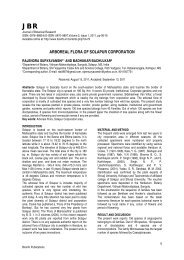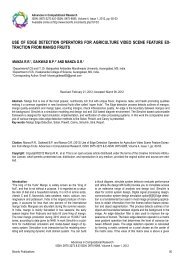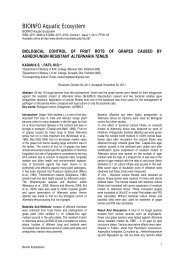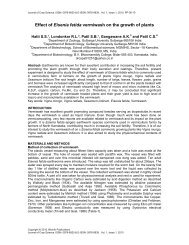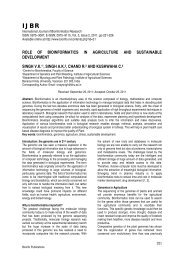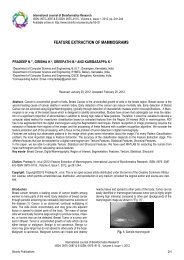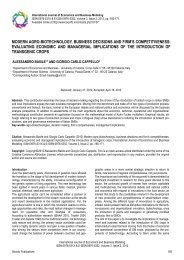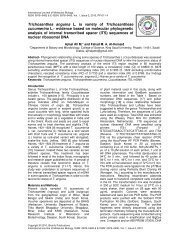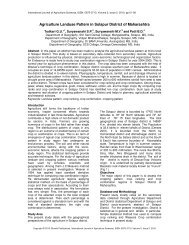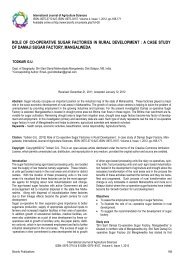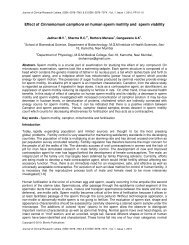In silico Study of tertiary structure and binding - Bioinfo Publications
In silico Study of tertiary structure and binding - Bioinfo Publications
In silico Study of tertiary structure and binding - Bioinfo Publications
Create successful ePaper yourself
Turn your PDF publications into a flip-book with our unique Google optimized e-Paper software.
<strong>In</strong>ternational Journal <strong>of</strong> Agriculture Sciences, ISSN: 0975-3710, Volume 1, Issue 1, 2009, pp-01-10<br />
<strong>In</strong> <strong>silico</strong> <strong>Study</strong> <strong>of</strong> <strong>tertiary</strong> <strong>structure</strong> <strong>and</strong> <strong>binding</strong> interaction <strong>of</strong> Pr<strong>of</strong>ilin –<br />
Schizosaccharomyces pombe<br />
Gangawane A.K .1,* , Gomase V.S. 1 , Anjali R. 1 <strong>and</strong> Patil C.S. 2<br />
*1 Department <strong>of</strong> Biotechnology <strong>and</strong> <strong>Bioinfo</strong>rmatics, Padmashree Dr. D. Y. Patil University, Sector 15, CBD Belapur, Navi Mumbai-<br />
400614, Email- ajganga@yahoo.com<br />
2 B V Bhoomraddi College <strong>of</strong> Arts, Sci <strong>and</strong> Com, Bidar, Dist- Bidar, Karnataka, <strong>In</strong>dia-585403<br />
Abstract-Pr<strong>of</strong>ilin plays a crucial role by directly linking actin cytoskeleton dynamics to various signal transduction<br />
pathways. Pr<strong>of</strong>ilin has been well conserved during the evolution <strong>and</strong> can be found throughout the animal <strong>and</strong> plant<br />
kingdom. All known pr<strong>of</strong>ilin are defined by common structural <strong>and</strong> biochemical properties <strong>and</strong> are known to interact<br />
with at least three types <strong>of</strong> lig<strong>and</strong>s: they are complex with the G actin <strong>and</strong> actin – related proteins; interact with PLP<br />
presented either as a peptide or as a sequence motif within specific proteins (with the exception <strong>of</strong> vaccinia pr<strong>of</strong>ilin),<br />
<strong>and</strong> bind to polyphosphoinositides. Pr<strong>of</strong>ilin has different functional roles: Actin <strong>binding</strong> <strong>and</strong> membrane refluxes,<br />
regulation <strong>of</strong> phospholipase C-Y1, focal contacts, nuclear transport <strong>of</strong> proteins, allergen, <strong>and</strong> tumor suppression. A<br />
protein function is tightly linked to its <strong>tertiary</strong> <strong>structure</strong> <strong>and</strong> as a residue located far apart in the sequence can be very<br />
close in space, <strong>and</strong> only few residues are responsible for a proteins function, insights into the <strong>tertiary</strong> <strong>structure</strong> <strong>of</strong> a<br />
protein can represent a key component <strong>of</strong> the functional analysis process. The homology or comparative protein<br />
<strong>structure</strong> <strong>of</strong> pr<strong>of</strong>ilin was obtained by optimization <strong>of</strong> molecular probability density function (pdf) using the s<strong>of</strong>tware<br />
program MODELLER. A stable <strong>structure</strong> was obtained by fixing the atomic charges by CHARMM 22 force field, <strong>and</strong><br />
minimizing the energy by conjugate gradient method (1000 iterations) using NAMD s<strong>of</strong>tware. Protein- protein<br />
docking was carried out with Vegazz for pr<strong>of</strong>ilin dimer formation <strong>and</strong> pr<strong>of</strong>ilin –lig<strong>and</strong> interactions were studied with<br />
Auto dock s<strong>of</strong>tware programs. The in <strong>silico</strong> studies help in underst<strong>and</strong>ing the pr<strong>of</strong>ilin monomeric interaction <strong>and</strong> its<br />
effect on PLP <strong>binding</strong> <strong>and</strong> polyphosphoinositide interactions, the two important processes which regulate number <strong>of</strong><br />
signaling event.<br />
Keywords: Pr<strong>of</strong>ilin, Tertiary <strong>structure</strong>, docking studies, Schizosaccharomyces pombe<br />
List <strong>of</strong> Abbreviations: Poly (L-proline) - PLP, Probability density function- pdf, Actin <strong>binding</strong> proteins –ABPs,<br />
Vasodilator stimulated phosphoprotein- VASP, Structural classification <strong>of</strong> protein- SCOP<br />
<strong>In</strong>troduction:<br />
Pr<strong>of</strong>ilin has been well conserved during the evolution<br />
<strong>and</strong> can be found throughout the animal <strong>and</strong> plant<br />
kingdom 1 2, 3, 4<br />
. They are found in protozoa<br />
echinodermata, insect 5 <strong>and</strong> mammalian 6, 7 . The<br />
plant pr<strong>of</strong>ilin was first identified as an allergen from<br />
Birch pollen 8, 9 . Pr<strong>of</strong>ilin also plays a crucial role by<br />
directly linking actin cytoskeleton dynamics to various<br />
signal transduction pathways. Though pr<strong>of</strong>ilin a small<br />
protein it has amazingly diverse functions in the cells<br />
that continue to elude the underst<strong>and</strong>ing <strong>of</strong><br />
researchers even today, after two decades <strong>of</strong> its<br />
discovery. Pr<strong>of</strong>ilin was among the first actin <strong>binding</strong><br />
protein (ABPs) which is involved in regulation,<br />
organization <strong>and</strong> orchestration <strong>of</strong> the dynamic<br />
system 6 . It was found to interact with the membrane<br />
phosphoinositides <strong>and</strong> poly (L-proline) – PLP domain<br />
containing proteins such as VASP family protein, N-<br />
WASP <strong>and</strong> diaphanous 10 . Ena (Drosophila enabled),<br />
mena (Mammalian Ena), aczonin, drebrin I 11 p 85 a<br />
subunit <strong>of</strong> P-13 kinase 12 etc. Many other proline rich<br />
have been identified as pr<strong>of</strong>iling lig<strong>and</strong>s, such as a<br />
forming homology proteins, the actin related protein -<br />
2/3 complex 9 Arp 2/3complex). Recently pr<strong>of</strong>iling is<br />
also shows to play a role in tumor suppression 13 .All<br />
the known pr<strong>of</strong>iling is defined by common structural<br />
<strong>and</strong> biochemical properties <strong>and</strong> is known to interact<br />
with at least 3 types <strong>of</strong> lig<strong>and</strong>s: the complex with Gactin<br />
14, 15, 16 &17 <strong>and</strong> actin related protein 18 interact<br />
with PLP presented either as a peptide or as a<br />
sequence motifs within the specific proteins <strong>and</strong> binds<br />
to phosphoinositides 19, 20 . Pr<strong>of</strong>ilin comprise 124 to<br />
153 amino acid sequences although amino acid<br />
sequences <strong>of</strong> the common is<strong>of</strong>orms in distantly<br />
related species might show less than 25 % identify.<br />
Studies on pr<strong>of</strong>ilin from diverse sources show that<br />
they possess closely related <strong>tertiary</strong> <strong>structure</strong> 21 . The<br />
sequence alignment <strong>of</strong> plant pr<strong>of</strong>ilin show that they<br />
are linearly ranging from 131 to 137 amino acids. The<br />
X ray <strong>structure</strong> determination <strong>of</strong> human <strong>and</strong> bovine<br />
pr<strong>of</strong>iling I showed that it forms two major contacts with<br />
actin in the crystal. The <strong>binding</strong> <strong>of</strong> pr<strong>of</strong>iling to lig<strong>and</strong>s<br />
might provide a means <strong>of</strong> linking different pathways,<br />
by mechanism that remains unclear, to cytoskeleton<br />
dynamics (Figure 1). The first proline rich protein to<br />
be identified as pr<strong>of</strong>iling lig<strong>and</strong>s is vasodilator<br />
stimulated phosphoprotein (VASP) 22 . It is an in vitro<br />
substrate <strong>of</strong> protein kinase C <strong>and</strong> P14m 5P2 is the<br />
effective activator <strong>of</strong> pr<strong>of</strong>iling phosphorylation by PKC<br />
23 .The pr<strong>of</strong>ilin molecule is unique in having positive<br />
<strong>and</strong> negative effects on polymerization <strong>of</strong> actin. It<br />
also helps in polymerization <strong>and</strong> depolymerization <strong>of</strong><br />
actin 23,24,25,26 . Pr<strong>of</strong>ilin is shown to interact with the<br />
scaffolding proteins in neurons 27 . It is an important<br />
plant allergen 8, 9 . PFN1 <strong>and</strong> PNF2 are present in<br />
Copyright © 2009, <strong>Bioinfo</strong> <strong>Publications</strong>, <strong>In</strong>ternational Journal <strong>of</strong> Agriculture Sciences, ISSN: 0975-3710, Volume 1, Issue 1, 2009
<strong>In</strong> <strong>silico</strong> <strong>Study</strong> <strong>of</strong> <strong>tertiary</strong> <strong>structure</strong> <strong>and</strong> <strong>binding</strong> interaction <strong>of</strong> Pr<strong>of</strong>ilin – Schizosaccharomyces pombe<br />
many organisms, <strong>of</strong> which the ubiquitously expressed<br />
PFN1 is considered for normal cellular functions 28,<br />
13 .The many neurospora has provided insights into<br />
biological processes have been enumerated briefly 29,<br />
30 . The entire genome <strong>of</strong> the species contains 38,<br />
69,769 base pairs <strong>of</strong> DNA encode: 10,082 proteins<br />
(9,200 <strong>of</strong> them longer ect than 100 amino acid) 424<br />
tRNAs, 74 rRNAs, 175-200 copies <strong>of</strong> the 25S/17S/<br />
5.8S gene cluster 31 .<br />
Materials <strong>and</strong> Methods<br />
Tools for in <strong>silico</strong> analysis<br />
Sequence analysis<br />
<strong>In</strong> this protocol we analyzed the sequence <strong>of</strong> pr<strong>of</strong>iling<br />
from Neurospora crassa.<br />
Multiple sequence alignment<br />
We used dynamic programming for analysis <strong>of</strong><br />
conserved region from set <strong>of</strong> gene which is similar in<br />
diversified species.<br />
MSWQAYVDSSLVGTGHIDKAAIISAAGDSTWAATP<br />
GFTLSPDEMKFISAVLGDNGKGSNVDKVFAEGLHV<br />
AGQRYVAFNIEGRHVYRQGKTGVIIVKTTQAILVAHY<br />
GENAVAGNSTQTVEALADYLVKAGY (GenBank<br />
85106701)<br />
Structure analysis<br />
The 3D SM server takes the sequence <strong>of</strong> the protein<br />
which is interesting <strong>and</strong> attempts to predict its 3D –<br />
<strong>structure</strong> <strong>and</strong> also its function. The probe is scanned<br />
by 3D-PSSM library using the global dynamic<br />
programming algorithm. The amino acid sequence <strong>of</strong><br />
the protein <strong>of</strong> interest is submitted in FASTA format<br />
with a one line description about the protein. An<br />
email ID is indispensable as the result are mailed<br />
MSWQAYVDSSLVGTGHIDKAAIISAAGDSTWAATP<br />
GFTLSPDEMKFISAVLGDNGKGSNVDKVFAEGLHV<br />
AGQRYVAFNIEGRHVYRQGKTGVIIVKTTQAILVAHY<br />
GENAVAGNSTQTVEALADYLVKAGY (GenBank<br />
85106701)<br />
The server generates the results with an in depth<br />
analysis. The browser comes up with proteins that<br />
are very similar to the query sequence after searching<br />
the non redundant protein databanks. The secondary<br />
<strong>structure</strong> is predicted by using PSI-Blast. The<br />
matching <strong>of</strong> the sequences the server comes up with<br />
the list <strong>of</strong> proteins with similar domain <strong>and</strong> also<br />
classifies the protein in to the super family based on<br />
its properties using SCOP- (Structural classification <strong>of</strong><br />
protein) by scanning the library.<br />
Spatial restraints<br />
MODELLER 32 is a computer program that models<br />
three dimensional <strong>structure</strong>s <strong>of</strong> proteins <strong>and</strong> their<br />
assemblies by satisfaction <strong>of</strong> spatial restraints.<br />
MODELLER is most frequently used for homology or<br />
comparative proteins <strong>structure</strong> modeling. The user<br />
provides an alignment <strong>of</strong> a sequence to be modeled<br />
with known related <strong>structure</strong> <strong>and</strong> MODELLER will<br />
automatically calculate a model with all non hydrogen<br />
atoms.<br />
There are three kinds <strong>of</strong> input files protein data Bank<br />
atom files with co-ordinates for the template <strong>structure</strong>,<br />
the alignment file with the alignment <strong>of</strong> the template<br />
<strong>structure</strong>s with the target sequence <strong>and</strong> MODELLER<br />
comm<strong>and</strong>s in script files that instruct MODELLER<br />
what to do.<br />
Each atom file is named code.atm where code is a<br />
short protein code –PDB code while 1ypr.atm the<br />
code must be used as that proteins identifier<br />
throughout the modeling. The alignment is done in<br />
PIR format. MODELLER is comm<strong>and</strong> line only tool<br />
<strong>and</strong> has no graphical user interface; MODELLER<br />
comm<strong>and</strong>s<br />
Stereo chemical analysis<br />
PROCHECK suite <strong>of</strong> programs 33 for assessing the<br />
stereo chemical quality <strong>of</strong> a given protein <strong>structure</strong>.<br />
The aim <strong>of</strong> PROCHECK is to assess how normal or<br />
conversely how unusual, the geometry <strong>of</strong> the residues<br />
in a given protein <strong>structure</strong> is as compared with stereo<br />
chemical parameters derived from well refined high<br />
resolution <strong>structure</strong>s. The parameters are to be<br />
described in details 34 .<br />
PROCHECK is the PDB file 35 holding the co-ordinates<br />
<strong>of</strong> the <strong>structure</strong> <strong>of</strong> interest. PROCHECK generates a<br />
number <strong>of</strong> output files in the default directory which<br />
have the same name as the original PBD file but with<br />
different extensions.<br />
Molecular optimization<br />
The program Auto Dock was developed to provide an<br />
automated procedure for predicting the interaction <strong>of</strong><br />
lig<strong>and</strong>s with biomolecular targets. The motivation for<br />
this work arises from problems in the design <strong>of</strong><br />
bioactive compounds <strong>and</strong> in particular the field <strong>of</strong><br />
computer aided drug design. Bio macromolecule: -<br />
Neurospora crassa pr<strong>of</strong>ilin <strong>and</strong> Lig<strong>and</strong>s: - Poly-L –<br />
proline<br />
Results & <strong>In</strong>terpretation<br />
The template selection was carried out on basis <strong>of</strong><br />
sequence <strong>and</strong> secondary <strong>structure</strong> similarity, (Table<br />
1) shows the results <strong>of</strong> the search programs<br />
mentioned above <strong>and</strong> their respective statistical<br />
scores that were considered in selecting the best<br />
template. A systematic representation <strong>of</strong> the multiple<br />
sequence alignment <strong>of</strong> target Neurospora crassa<br />
<strong>In</strong>ternational Journal <strong>of</strong> Agriculture Sciences, ISSN: 0975-3710, Volume 1, Issue 1, 2009 2
pr<strong>of</strong>ilin sequence with their respective template<br />
proteins <strong>and</strong> their secondary <strong>structure</strong> details are<br />
shown respectively. Neurospora crassa pr<strong>of</strong>ilin share<br />
43% similarity with Saccharomyces cerevisiae (Table<br />
1 & Figure 2). The 3D <strong>structure</strong> model <strong>of</strong> Neurospora<br />
crassa pr<strong>of</strong>ilin was built by using MODELLER 9v1<br />
tool. The few amino acids which were in disallowed<br />
region <strong>of</strong> Ramch<strong>and</strong>ran plot were also modeled<br />
(Table 2 &3). The final model shows an improved<br />
Ramch<strong>and</strong>ran plot <strong>and</strong> energy pr<strong>of</strong>iles with respect to<br />
the initial models (Table 4). This cycle <strong>of</strong> loop<br />
building minimization <strong>and</strong> evaluation was done till no<br />
further improvement in the <strong>structure</strong> can be made<br />
(Figure 3 <strong>and</strong> 4). The improved model was evaluated<br />
using programs PROCHECK <strong>and</strong> Verify 3D (Figure<br />
5). The dimer was obtained by docking two monomer<br />
<strong>of</strong> Neurospora crassa. Dimers were screened based<br />
on the <strong>binding</strong> affinities <strong>and</strong> the top ranked dimer was<br />
selected with good steric fit. It was further subjected<br />
to energy minimization with the steepest descent<br />
algorithm for optimization in Swiss PDB viewer. The<br />
electrostatic energy <strong>of</strong> the complex was found to be -<br />
6394 KJ/mol. The <strong>binding</strong> free energy was found to<br />
be -9.924380Kcal/mol. Docked complex ranked 6<br />
(based on electrostatic term) was found to be more<br />
close to the biological information available for the<br />
dimer formation (Figure 6). The crystal <strong>structure</strong> <strong>of</strong><br />
human pr<strong>of</strong>ilin tetramer is available. The tetramer<br />
was obtained by docking two dimer <strong>of</strong> Neurospora<br />
crassa (Figure 7). A model <strong>of</strong> Neurospora crassa<br />
pr<strong>of</strong>ilin PLP complex was obtained by docking<br />
Neurospora crassa pr<strong>of</strong>ilin monomer with PLP by<br />
using AUTO DOCK. PLP <strong>structure</strong> was obtained from<br />
crystal <strong>structure</strong> <strong>of</strong> human pr<strong>of</strong>ilin I-PLP complex.<br />
The complex <strong>structure</strong> obtained after energy<br />
minimization was used for further analysis (Figure 8).<br />
Conclusion<br />
Pr<strong>of</strong>ilin has been <strong>of</strong> great interest to biophysicists<br />
owing to its abundance in the cell <strong>and</strong> lot <strong>of</strong> structural<br />
data is available on pr<strong>of</strong>ilin monomer. The structural<br />
similarity between Neurospora crassa pr<strong>of</strong>ilin <strong>and</strong><br />
human pr<strong>of</strong>ilin is forms was between 20-32%. <strong>In</strong><br />
<strong>silico</strong> model <strong>of</strong> Neurospora crassa <strong>and</strong><br />
Saccharomyces cerevisiae pr<strong>of</strong>ilin showed 43%<br />
identical. The model was evaluated using programs<br />
Procheck <strong>and</strong> verify3D. Solvent pockets were<br />
generated by using POPS server. Oligomers <strong>of</strong><br />
Schizosaccharomyces pombe pr<strong>of</strong>ilin were also<br />
obtained, Monomer-Monomer docking; to form Dimer<br />
<strong>and</strong> again two dimer were docked together to obtain<br />
tetramer (using Vega ZZ dock). <strong>In</strong>-<strong>silico</strong> analysis was<br />
compared with human pr<strong>of</strong>ilin data<br />
Schizosaccharomyces pombe Pr<strong>of</strong>ilin also contain<br />
conserved residue also known as “Pr<strong>of</strong>ilin motif”<br />
TRP3 ASN4 ALA5 TYR6. The Schizosaccharomyces<br />
pombe Pr<strong>of</strong>ilin dimer obtained with docking shows<br />
during dimer formation “N” <strong>and</strong> “C” terminal are in<br />
accessible with PLP same as previously obtained<br />
result for human <strong>and</strong> bovine pr<strong>of</strong>ilin 36 . Slime pr<strong>of</strong>ilin<br />
Gangawane AK, Gomase VS, Anjali R <strong>and</strong> Patil CS<br />
exists in three forms monomer, dimer <strong>and</strong> tetramer<br />
similar to human pr<strong>of</strong>ilin. It also exhibits in vitro<br />
oligomerization <strong>and</strong> only tetramer/ monomer pr<strong>of</strong>ilin<br />
binds with PLP. Dimer did not shows <strong>binding</strong> to PLP<br />
due to inaccessible PLP Binding region.<br />
Acknowledgement<br />
We are thankful to the Department <strong>of</strong> Biotechnology<br />
<strong>and</strong> <strong>Bioinfo</strong>rmatics, Padmashree Dr. D. Y. Patil<br />
University, Navi Mumbai for providing the financial<br />
<strong>and</strong> technical support.<br />
References<br />
1. Markey, F., Lindberg, U., <strong>and</strong> Erikson.L.<br />
(1978) FEBES letter 88:75-79<br />
2. Reichstein, E., <strong>and</strong> Korn, E.D.(1979)J Biol<br />
Chem. 254: 6174-6179<br />
3. Ozaki, K., Sugino, H., Hasegawa, T.,<br />
Takahashi, S., Hatano, S. (1983) J Biochem.<br />
93: 295-298<br />
4. Haugwitz, M., Noegel, A., Reider, R d.,<br />
Lotispeich, P., <strong>and</strong> Schleicher, M.(1991)<br />
J.Cell Science 100: 481-489<br />
5. Cooley, L., Verheyen, E., <strong>and</strong><br />
Ayers,K.(1992) Cell 69: 173-184, Trends Cell<br />
Biol 13: 435-446<br />
6. Carlsson,L., Nystrom, L.E., Lindberg, U.,<br />
Kannan K K., Cid- Dresdner, H., Lovergren,<br />
S., <strong>and</strong> Jornvall, H (1976) J.Mol Biol 105:<br />
353-366<br />
7. Kwiatkowski, N., <strong>and</strong> Bruns, G.A. (1988) J<br />
Biol Chem 263: 5910-5915<br />
8. Valenta, R., m., Breitenbach, M.,<br />
Pettennburger, K., Koller, L., Rumpold, H.,<br />
Scheiner, O., <strong>and</strong> Kraft, D. (1991) <strong>In</strong>t Arch<br />
Allergy Appl Immunol 94: 368-370<br />
9. Valenta, R., Duchene, M., Eber, C., Valent,<br />
P., Sillaber, C., Deviller,P., Ferreira, F.,<br />
Tajkl,M., Edelmann, H., Kraft, D., <strong>and</strong><br />
Scheiner, O. (1992) J Exp Med 175: 377-385<br />
10. Holt M,.R., K<strong>of</strong>fer, A (2001) Trends Cell<br />
Biology 11: 38-46<br />
11. Witke, W., Podtelejnikov, A, V., Di Nardo, A.,<br />
Sutherl<strong>and</strong>, J.D., Gurniak, C.B., Dotti, C &<br />
Mann, M (1998) EMBO J 17: 967-976<br />
12. Surya S. Singh, Abha Chauhan, Noriiko<br />
Murakami, James Styles, Marshall Elzinga<br />
Copyright © 2009, <strong>Bioinfo</strong> <strong>Publications</strong>, <strong>In</strong>ternational Journal <strong>of</strong> Agriculture Sciences, ISSN: 0975-3710, Volume 1, Issue 1, 2009<br />
3
<strong>In</strong> <strong>silico</strong> <strong>Study</strong> <strong>of</strong> <strong>tertiary</strong> <strong>structure</strong> <strong>and</strong> <strong>binding</strong> interaction <strong>of</strong> Pr<strong>of</strong>ilin – Schizosaccharomyces pombe<br />
<strong>and</strong> Ved P.S., Chauhan (1996) Receptors<br />
<strong>and</strong> Signal transduction 6(2) 77-86<br />
13. Janke, J., Schluter, K., J<strong>and</strong>rig, B., Theile,<br />
M., Kolble, K., Arnold, W., Grinstein E.,<br />
Schwartz, A., Estevez-Schwarz, L., Schlag,<br />
P M ( 2000) J Exp Med 191: 1675-1686<br />
14. Carlsson,L., Nystrom, L.E., Sundkvist, I.,<br />
Markey, F., Lindberg, U. (1977) J Mol.Biol<br />
115 : 465-483<br />
15. Tseng, P.C., <strong>and</strong> Pollard, T.D (1982) J Cell<br />
Biol 94 : 213-218<br />
16. Tobacman, L.S., Brenner, S.L., Korn, E.D<br />
(1983) J Biol Chem 258: 8806-8812<br />
17. Schutt, C.E., Lindberg, U., Myslik, J.,<br />
Strauss, N., (1989) J Mol Biol 209: 735-746<br />
18. Machesky, L., Cole, N., Moss, B., <strong>and</strong><br />
Pollard, T.,(1994) Biochemistry 33: 10815-<br />
10824<br />
19. Lasssing, I., <strong>and</strong> Lindberg, U. (1985) Nature<br />
314: 472-474<br />
20. Lasssing, I., <strong>and</strong> Lindberg, U. (1985) J Cell<br />
Biochem 37: 255-267<br />
21. Fedorov, A.A., Pollard, T.D., <strong>and</strong> Almo, S.C<br />
(1994) J Mol Biol 241: 480-482<br />
22. Reinhard, M., Giehl, K., Abel. K., Haffner, C.,<br />
Jarchau, T., Hoppe, V., Jockusch, B.M., <strong>and</strong><br />
Walter U ( 1995) EMBO J 14: 1583-1589<br />
23. Hansson, A., Goran Skoogl<strong>and</strong>, <strong>In</strong>grid<br />
Lassing, UnoLindberg <strong>and</strong> Magnus <strong>In</strong>gelman<br />
Sundberg (1988) Biochemical <strong>and</strong><br />
Biophysical Research Communication<br />
150(2) : 526-531<br />
24. Pantaloni, D., Carlier, M F (1993) Cell 75:<br />
1007-1014<br />
25. Pollard, T.D (1984) J Cell Biol 99: 769-777<br />
26. Pring , M., Weber, A., <strong>and</strong> Bubb, M,R (1992)<br />
Biochemistry 31: 1827-1836<br />
27. Mammoto, a., Sasaki, T., Asakura, T., Hotta,<br />
I., Imamura, H., Takahashi. K., Matsuura,<br />
Y.,Sirao, T., <strong>and</strong> Takai, Y., (1998)<br />
Biochemical <strong>and</strong> Biophysical Research<br />
Communication 24: 86-89<br />
28. Wittenmayer N., Burkhard J<strong>and</strong>rig, martin<br />
Rothkegel, Karthrin Schluter, Wolfgang A,<br />
Wolfgang H, Siegfried Scherneck <strong>and</strong><br />
Brigitte M. Jockusch (2004) Molecular<br />
biology <strong>of</strong> the Cell 15: 1600-1608<br />
29. Horowitz N H.(1991) Genetics 127: 631-636<br />
30. Perkins.D.D (1992) Genetics : 130: 687-701<br />
31. Giraldo R (2003) Nat Struct Biol 10: 565-571<br />
32. M.A. MartiRenom, A. Stuart, A. Fiser, R,<br />
Sanchez, F. Melo, A. Sali (2000) Annu Rev.<br />
Biophys Biomol 29: 291-325<br />
33. Laskowski R A., Mac Arthur M W., Moss D S<br />
& Thornton J M (1993) J Appl Cryst 26: 283-<br />
291<br />
34. Morris A L., Mac Arthur M W., Hutchinson E<br />
G & Thornton J M (1992) Proteins 12: 345-<br />
364<br />
35. Breitwieser , G E (2004) Circ Res 94: 17-27<br />
36. Mahoney, NM., Janmey, PA., <strong>and</strong> Almo,<br />
S.C.(1997) Nat Struct Biol 4: 953-960<br />
<strong>In</strong>ternational Journal <strong>of</strong> Agriculture Sciences, ISSN: 0975-3710, Volume 1, Issue 1, 2009 4
Figure 1: - Structure <strong>and</strong> Function <strong>of</strong> pr<strong>of</strong>ilin<br />
Table 1: - Sequence <strong>of</strong> pr<strong>of</strong>ilin from various sources <strong>and</strong> their amino acid residues<br />
Sequence Organism Amino acid residues<br />
Sequence 1 Schizosaccharomyces pombe 127<br />
Sequence 2 Saccharomyces cerevisiae 126<br />
Sequence 3 Neurospora crassa 133<br />
Sequence 4 Rattus norvegicus 140<br />
Sequence 5 Homo sapiens Pr<strong>of</strong>ilin 1 140<br />
Sequence 6 Homo sapiens Pr<strong>of</strong>ilin 2 140<br />
Sequence 7 Homo sapiens Pr<strong>of</strong>ilin 3 129<br />
Sequence 8 Homo sapiens Pr<strong>of</strong>ilin 4 137<br />
Sequence 9 Bovine Pr<strong>of</strong>ilin 1 140<br />
Sequence 10 Arabidopsis thaliana 131<br />
Sequence 11 Nicotiana tabacum 134<br />
Sequence 12 Aspergillus niger 131<br />
Sequence 13 Variola virus 133<br />
Gangawane AK, Gomase VS, Anjali R <strong>and</strong> Patil CS<br />
Copyright © 2009, <strong>Bioinfo</strong> <strong>Publications</strong>, <strong>In</strong>ternational Journal <strong>of</strong> Agriculture Sciences, ISSN: 0975-3710, Volume 1, Issue 1, 2009<br />
5
<strong>In</strong> <strong>silico</strong> <strong>Study</strong> <strong>of</strong> <strong>tertiary</strong> <strong>structure</strong> <strong>and</strong> <strong>binding</strong> interaction <strong>of</strong> Pr<strong>of</strong>ilin – Schizosaccharomyces pombe<br />
Figure 2: - 2D Confirmation generated from 3D PSSM Server<br />
Figure 3: - Schizosaccharomyces pombe pr<strong>of</strong>ilin was built by using Modeller 9v1 tool.<br />
<strong>In</strong>ternational Journal <strong>of</strong> Agriculture Sciences, ISSN: 0975-3710, Volume 1, Issue 1, 2009 6
Figure 4: - Validation <strong>of</strong> protein <strong>structure</strong> using Ramch<strong>and</strong>ran plot<br />
Table 2: - Ramach<strong>and</strong>ran Plot Statistics<br />
Gangawane AK, Gomase VS, Anjali R <strong>and</strong> Patil CS<br />
Copyright © 2009, <strong>Bioinfo</strong> <strong>Publications</strong>, <strong>In</strong>ternational Journal <strong>of</strong> Agriculture Sciences, ISSN: 0975-3710, Volume 1, Issue 1, 2009<br />
7
Figure 5: - Verify 3D<br />
<strong>In</strong> <strong>silico</strong> <strong>Study</strong> <strong>of</strong> <strong>tertiary</strong> <strong>structure</strong> <strong>and</strong> <strong>binding</strong> interaction <strong>of</strong> Pr<strong>of</strong>ilin – Schizosaccharomyces pombe<br />
Table 3:- G-Factors<br />
<strong>In</strong>ternational Journal <strong>of</strong> Agriculture Sciences, ISSN: 0975-3710, Volume 1, Issue 1, 2009 8
Table 4: - Solvent Pockets Generated by POPS Server<br />
Three solvent pockets identified for the given protein PROF.pdb<br />
First solvent pocket 4Ang<br />
Gangawane AK, Gomase VS, Anjali R <strong>and</strong> Patil CS<br />
LYS19 ALA20 PHE37 LEU39 GLU43 PHE46 ILE47 VAL63 GLU66 GLY67 LEU68 HIS69 VAL70 TYR75 GLY93<br />
VAL94 ILE96 VAL105 ALA106 HIS107<br />
Second solvent pocket 4Ang<br />
ALA21 ILE22 ILE23 THR30 PHE37 LEU39 ILE47 ILE96 ILE103 VAL105<br />
Third solvent pocket 4Ang<br />
TRP3 ILE22 TRP31 VAL97 THR99 GLN101 ALA102 LEU104 VAL121 LEU124 ALA125 LEU128 TYR133<br />
Figure 6: - Dimer <strong>structure</strong> from two monomers <strong>of</strong> Schizosaccharomyces pombe.<br />
Figure 7: - The tetramer <strong>structure</strong> from two dimers <strong>of</strong> Schizosaccharomyces pombe<br />
Copyright © 2009, <strong>Bioinfo</strong> <strong>Publications</strong>, <strong>In</strong>ternational Journal <strong>of</strong> Agriculture Sciences, ISSN: 0975-3710, Volume 1, Issue 1, 2009<br />
9
<strong>In</strong> <strong>silico</strong> <strong>Study</strong> <strong>of</strong> <strong>tertiary</strong> <strong>structure</strong> <strong>and</strong> <strong>binding</strong> interaction <strong>of</strong> Pr<strong>of</strong>ilin – Schizosaccharomyces pombe<br />
Poly –L – Proline (PLP) Binding<br />
Figure 8: - Complex <strong>of</strong> Neurospora crassa pr<strong>of</strong>ilin monomer with PLP by Using AUTO DOCK.<br />
<strong>In</strong>ternational Journal <strong>of</strong> Agriculture Sciences, ISSN: 0975-3710, Volume 1, Issue 1, 2009 10


